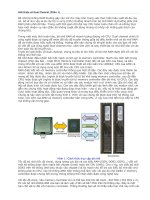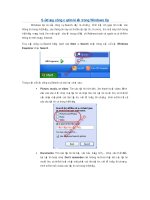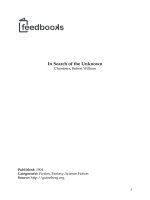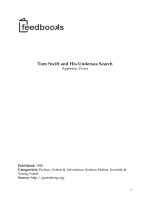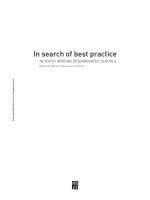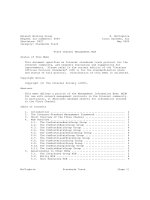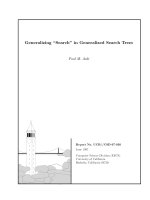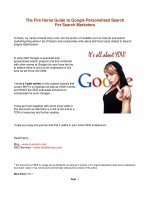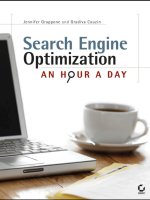Search engien advertersing channel subtiation
Bạn đang xem bản rút gọn của tài liệu. Xem và tải ngay bản đầy đủ của tài liệu tại đây (394.81 KB, 30 trang )
Search Engine Advertising:
Channel Substitution when Pricing Ads to
Context
Avi Goldfarb and Catherine Tucker*
September 2010
Abstract
We explore substitution patterns across advertising platforms. Using data on the advertising
prices paid by lawyers for 139 Google search terms in 195 locations, we exploit a natural
experiment in ―ambulance-chaser‖ regulations across states. When lawyers cannot contact clients
by mail, advertising prices per click for search engine advertisements are 5-7% higher.
Therefore, online advertising substitutes for offline advertising. This substitution towards online
advertising is strongest in markets with fewer customers, suggesting that the relationship
between the online and offline media is mediated by the marketers’ need to target their
communications.
*
Avi Goldfarb is Associate Professor of Marketing, Rotman School of Management, University of Toronto, 105 St
George St., Toronto, ON. Tel. 416-946-8604. Email: Catherine E. Tucker is
Assistant Professor of Marketing, MIT Sloan School of Business, 1 Amherst St., E40-167, Cambridge, MA. Tel.
617-252-1499. Email: We wish to thank Jayne Huang for excellent research assistance. We also
wish to thank the review team, Chris Dellarocas, Shane Frederick, Anindya Ghose, Shane Greenstein, and seminar
participants at SCECR 2007, LBS, the NET Institute conference (2008), the Fourth Workshop on Ad Auctions, and
the University of Toronto for comments. We thank the NET Institute () for financial
support.
Electronic
Electroniccopy
copyavailable
availableat:
at: /> />
1
1. Introduction
Online advertising has been one of the few advertising platforms that has shown revenue
growth over the past 5 years.1 An important question for marketers and policy makers is whether
this growing advertising channel (a) complements offline advertising channels, (b) operates
independently of offline advertising channels, or (c) substitutes for offline advertising channels.
The popular press and some of the marketing literature have emphasized the possibility
that online and offline advertising channels may be complements. By ―complements,‖ we mean
the idea that offline marketing can increase the value of online advertising, and vice versa. For
example, articles in the popular press (e.g. Elliott 2010, Frensley 2007) emphasize the
importance of ―synergies‖ between online and offline media. These articles argue that offline
media generate interest, while online media engage people and satisfy that interest. This
argument was emphasized in an industry white paper (DynamicLogic 2007) that demonstrates
that campaigns that use multiple media tend to be more successful. Two academic studies
(Lambert and Pregibon 2008 and Wilbur, Joo, and Zhu 2010) demonstrate that offline marketing
communications can generate searches on search engines.
In contrast, most of the theoretical literature has assumed that online and offline channels
are substitutes. Drawing on standard advertising models from economics and marketing, these
papers assume that showing an ad has the same effect, regardless of the channel used. For
example, Athey and Gans (2010) and Bergemann and Bonatti (2010) assume that firms substitute
between online and offline advertising channels.
In a third view, regulators have argued that these channels are neither complements nor
substitutes, but instead that online and offline advertising markets operate independently. The
1
This information is from PriceWaterhouseCoopers’ annual reports for the Interactive Advertising Bureau.
Electronic
Electroniccopy
copyavailable
availableat:
at: /> />
2
Federal Trade Commission made no mention of the offline advertising market in its approval of
the Google/DoubleClick merger (Federal Trade Commission 2008). The European Commission,
in its Google/DoubleClick and Microsoft/Yahoo decisions, declared that, for antitrust purposes,
―online advertising is a distinct market from offline advertising‖ (European Commission 2010,
paragraph 61).
Overall, the internet ―looms as a potential substitute or complement for all of the major
categories of existing media‖ (Silk et al. (2001)). To date, there is little empirical evidence on the
subject of whether it substitutes, complements or operates independently of offline media.2
This paper investigates whether there is substitution between online and offline channels
and how this is mediated by a need by advertisers to target their communications. We use
exogenous variation in the ability of advertisers to use one advertising sector to evaluate how it
affects their willingness to pay for another advertising sector. Specifically, we exploit state-level
variation in the ability of lawyers to solicit customers in cases related to recent personal injury or
death.3 Some state bar associations regulate this ―ambulance-chasing‖ behavior by forbidding
lawyers from contacting potential clients using traditional direct-response targeting methods (in
writing or by e-mail) for 30-45 days after an accident. We analyze the effects of these regulations
using data on estimated auction prices of 139 different searches for various legal service
keywords in 195 regional city markets. We regress a keyword’s estimated cost per click on fixed
effects for each location and keyword, and focus on an interaction variable that captures whether
the keyword is affected by state regulations.
2
The only exception we know of is Goldfarb and Tucker’s (2010a) study that documents the ability of online
display advertising to circumvent local offline advertising bans for alcohol billboards.
3
Throughout the paper, we use ―personal injury‖ to refer to both personal injury and wrongful death keywords.
When referring specifically to personal injury and not wrongful death, we use the label ―personal-injury-specific.‖
Electronic
Electroniccopy
copyavailable
availableat:
at: /> />
3
In locations with solicitation regulations, personal injury keywords cost advertisers
between 5% and 7% more relative to the price of other keywords (such as ―divorce lawyer‖) in
that state, compared with the price premium of personal injury keywords in non-regulated states.
This suggests that advertisers substitute the online channel for the offline channel.
We use three methods to check the robustness of our results to other potential sources of
omitted variables bias and endogeneity. First, we include numerous controls to capture
heterogeneity in the number of bidders, the client base, the local market for lawyers, awards in
personal injury cases, and the civil litigation regime. Second, we show robustness to alternative
definitions of treatment and control groups. Specifically, we use more limited control groups of
keywords relating to divorce law and misdemeanor offenses, which are areas of law that, like
personal injury law, are reputed to have aggressive lawyers. Third, we conduct two different
falsification checks. Our first falsification check focuses on Arkansas, where the solicitation
restrictions affect wrongful death but not personal injury specifically; the solicitation restrictions
in all other states apply to both personal injury and wrongful death. We show that, unlike other
states with solicitation restrictions, keyword prices for personal injury-specific words are not
disproportionately higher than other legal keywords in Arkansas, but are higher for wrongful
death keywords. Our other falsification test shows that other keyword categories (such as divorce
law) do not have price premiums in states with solicitation restrictions.
In order to understand this substitution, we investigate in which markets the substitution
is strongest. In search engine advertising, ads are displayed only when a customer uses a certain
search term and the price paid depends on an auction for that specific search term. This means
that search engine advertising is a particularly effective channel for targeted ads. We examine the
role of targeting and find that online prices for personal injury keywords are highest when there
Electronic copy available at: />
4
are a relatively small number of searches for a keyword. Prices for personal injury keywords
were also higher for cities with smaller populations. In these cases, where the number of
potential matches between advertiser and customer is smaller, regulations that shut down an
offline targeting mechanism have a substantial effect. In contrast, when there are many potential
clients, mass media advertising might be more effective and a reasonable alternative and there is
less need for firms to substitute into search advertising.
There has been growing theoretical interest in studying the relationship between online
and offline media through the lens of targeting (Athey and Gans 2010; Bergemann and Bonatti
2009). Our research contributes an improved empirical understanding of these relationships. Our
research also extends a previous empirical literature that documented how better targeting of ads
can increase advertiser and customer welfare. For example, Narayanan and Manchanda (2009)
and Dong, Manchanda, and Chintagunta (2009) show that targeting improves pharmaceutical
detailing; and Goldfarb and Tucker (2010b) document that contextually targeted display ads are
more effective in driving purchase intent. The emphasis on targeting effectiveness follows the
theoretical literature in marketing (Iyer, Soberman, and Villas-Boas 2005; Gal-Or and Gal-Or
2005), that has modeled the effects on advertiser and consumer welfare implied by targeting.
Our results also inform a growing literature on search engine advertising. The empirical
literature on search engine advertising has also focused on the quality of customer leads postclick. For example, Ghose and Yang (2009) and Rutz and Bucklin (2007) have shown the effects
of different keywords on customer conversion. Our research adds to this literature, by
emphasizing the roles that offline channels and the targeting of keywords can have on the prices
advertisers pay for search engine ads.
Electronic copy available at: />
5
Overall, our results suggest that search engine advertising acts as a substitute for a
traditional form of offline marketing communications. Furthermore, the result that this
substitution is strongest in markets with fewer potential customers suggests that search engines
allow firms to reach the hardest-to-find customers, enabling a ―long tail‖ in advertising
(Anderson 2006). This suggests an efficiency-driven welfare improvement despite the high
prices: Keyword search advertising is most valuable when customers cannot be reached through
other channels.
2. Data on Advertising Prices for Lawyer Services
We use data collected from Google’s ―Traffic Estimator Tool,‖ which provides potential
advertisers with a guide to the auction prices that they would expect to pay for different
keywords in different locations.4 The traffic estimator provides (given enough data points) a
range of prices for each keyword that other advertisers have recently paid for an ad to appear in
the top three positions in a certain city and the search volume associated with that price range.5
Our data contain projections for 139 keywords in 195 geographic areas defined by Google to
closely resemble (consolidated) metropolitan statistical areas. Our keywords cover many
different types of legal representation, from "child custody lawyers" to "truck accident
attorneys," and are summarized in Online Appendix Table 1. In order to use our natural
experiment of state-level restrictions, we exclude metropolitan statistical areas that cross state
lines, such as Burlington, VT–Plattsburg, NY and New Bedford, MA–Providence, RI. Table 1
provides descriptive statistics for the data used in this study.
4
Our focus on paid search as the source of revenues for search engines means that we do not consider issues of nonpaid search such as those discussed by Katona and Sarvary (2009).
5
Google also requests a maximum bid price. In all cases the maximum willingness to pay entered was $100, to
ensure that this did not bind the results.
Electronic copy available at: />
6
Table 1: Descriptive Statistics
Variable
Number of
Mean Standard Minimum Maximum
observations
deviation
Cost per click (midpoint)
Daily search volume
Personal injury keyword
12,271
12,271
12,271
9.28
0.156
0.187
7.650
0.397
0.389
0
0
0
52.87
3
1
There are two major challenges to using these data: Interpreting price data from an
auction mechanism and missing data. We discuss each in turn. With data from the Traffic
Estimator Tool, we use the exact information advertisers have in setting their bid prices. Since
2002, Google and Yahoo have sold keywords using second-price sealed bid auctions instead of
using less stable first-price auctions (Edelman, Ostrovsky, and Schwarz 2007). However, the
form of second-price auction used obscures how bids translate into prices. An advertiser places a
bid based on its maximum willingness to pay for an ad to appear next to a specific search term
for a specific geographical location. Google then bills a sum lower than this maximum price
whenever the ad is clicked. However, an advertiser is not necessarily paying the second price
that was bid in that particular auction. Instead, keyword prices post-bidding are adjusted for the
quality of the website buying the keyword, click fraud, and the clicks-to-impression ratio, with
no information given to advertisers (or researchers) about the precise formulas used. In this
paper, we use ―estimated prices‖ data for Google that abstract from this ex post quality
adjustment. The key assumption for the interpretation of our results to be valid is that, on
average, the relative price estimates reflect the relative values of the keywords in the market. In
other words, measurement error will reduce the size of our estimates unless there is a systematic
reason that personal injury keyword prices in states with solicitation regulations are
overestimated using the Traffic Estimator Tool relative to all other keyword prices.
Electronic copy available at: />
7
Google reports the cost per click range only when they have enough historical data. Little
(1992) emphasizes that missing data are problematic when systematically correlated with the
explanatory variables. We therefore confirmed that missing data in our dataset are not
systematically correlated with the type of keyword or the solicitation regulations we use later in
the paper for identification.
Another challenge of using these data is that Google gives a price range, but not an
indication of the distribution of prices paid between these lower and upper cutoffs. We mostly
report results for the midpoint of this range. We have repeated all of our specifications using
both the upper and lower limits, and obtained qualitatively similar results. Again, to support our
qualitative results, all we need is for the keyword price estimates to be correlated with the actual
prices paid and to have no other systematic correlation to the regulation.6
2.1. Variation in Restrictions on Lawyer Behavior
Our natural experiment exploits state-level restrictions on personal injury lawyer
behavior. Personal injury lawyers earned $40 billion in 2004 in the United States, an amount that
was more than 50% higher than Microsoft or Intel and twice that of Coca-Cola (Copland 2004).
The personal injury lawyer industry has two attractive features that make the identification of
how targeting difficulty affects search advertising prices relatively straightforward. These are:
(1) Sub-national markets due to state-level admittance to the bar and the small scale of personalinjury lawyer practices,7 and (2) variation in rules regarding solicitation by personal injury
lawyers across states. We use this variation in solicitation regulations to establish whether search
6
In a separate dataset on search advertising for web services, we explored the correlation between the estimates
provided by the traffic estimator tool and actual prices paid. We found that there was a correlation of over 0.95
between the prices suggested by the traffic estimator tool and the prices charged to the advertiser on the first two
days of advertising, before Google had enough data to make quality adjustments.
7
Although several states have reciprocity agreements with lawyers in other states, the small-scale nature of most
personal injury claims means that cases are typically tried locally by local lawyers.
Electronic copy available at: />
8
ads have higher prices when offline targeting is more difficult. The regulation gives us a natural
experiment with a treatment group of locations affected by the regulation and a control group of
locations that are not affected. To control for systematic differences between regulated and
unregulated states, we contrast keyword prices affected by regulation with keyword prices that
are unaffected by the state regulations in regulated states. Therefore, we estimate how much
affected keywords diverge in price from unaffected keywords in regulated locations relative to
unregulated locations.
In 1977, the Supreme Court deregulated legal advertising in Bates v. the State Bar of
Arizona. This deregulation prompted a spate of empirical evaluation of legal services advertising
by marketing scholars (Kotler and Connor 1977; Smith and Meyer 1980; Darden et al. 1981).
However, the deregulation was not complete: Still today, some state bar regulations prohibit
lawyers from directly contacting potential clients who have recently sustained an accident or
injury.8 A typical text in a state bar manual is found in a section entitled ―solicitation,‖ and reads:
―A lawyer shall not send, or knowingly permit to be sent, on a lawyer’s behalf or on behalf of the
lawyer’s firm or on behalf of a partner, an associate, or any other lawyer affiliated with the lawyer or
the lawyer’s firm, a written communication (including electronic communication) to a prospective
client for the purpose of obtaining professional employment if the written communication concerns an
action for personal injury or wrongful death arising out of, or otherwise related to, an accident or
disaster involving the person to whom the communication is addressed or a relative of that person,
8
The Supreme Court considered this matter in Florida Bar v. Went for It, Inc. (Supreme Court of the United States
1995). It was a close 5-4 decision, but the majority ruled that, while such practices may limit free speech, states also
have a constitutional right to protect the privacy of their citizens. The decision refers to some interesting anecdotal
evidence that was used to justify the ruling and solicitation regulations such as those studied in this paper. For
example, a Florida citizen described how he was ―appalled and angered by the brazen attempt‖ of a law firm to
solicit him by letter shortly after he was injured and his fiancée was killed in an auto accident. Another citizen
described a letter his nephew's family received on the day of the nephew's funeral as ―beyond comprehension.‖ One
citizen wrote, ―I consider the unsolicited contact from you after my child's accident to be of the rankest form of
ambulance chasing and in incredibly poor taste […] I cannot begin to express with my limited vocabulary the utter
contempt in which I hold you and your kind.‖
Electronic copy available at: />
9
unless the accident or disaster giving rise to the cause of action occurred more than X days before the
mailing of the communication.‖
Table 2 records all regulations as of April 2007 where a state bar association forbids
written communication with potential clients. In each case, ―written communication‖ includes
direct electronic communication such as e-mail.9 There is a little variation over how long the
states prohibit contact (the mode is 30 days), but the regulations are similar. These regulations
affect a significant part of lawyer advertising behavior. In 1989, before the change in bar
association regulation in Florida, the association reported that of 700,000 direct solicitations sent,
40% were to accident victims or their relatives.
Table 2: Bar regulations/rules prohibiting contact with clients
State
Alabama
Arizona
Arkansas
Colorado
Connecticut
Florida
Georgia
Hawaii
Louisiana
Missouri
Nevada
New York
Personal injury regulations
No written communication allowed for 30 days for personal injury or wrongful death
No written communication allowed for 30 days for personal injury or wrongful death
No written communication allowed for 30 days for wrongful death
No written communication allowed for 30 days for personal injury or death
No written communication allowed for 40 days for personal injury or death
No written communication allowed for 30 days for personal injury or wrongful death
No written communication allowed for 30 days for personal injury or wrongful death
No written communication allowed for 30 days for personal injury or wrongful death
No written communication allowed for 30 days for personal injury or wrongful death
No written communication allowed for 30 days for personal injury or wrongful death (accident or disaster)
Must wait 45 days after any known event before written communication
No written communication allowed for 30 days for personal injury or wrongful death unless law says
need to file in 30 days in which case cannot solicit for 15 days
South Carolina No written communication allowed for 30 days for personal injury or wrongful death
No written communication allowed for 30 days for workers’ comp., personal injury, or wrongful death
Tennessee
For written communications, need to wait 30 days after ―occurrence‖ before soliciting a specific client
Wyoming
Personal injury keywords can be identified objectively because bar associations use a
precise legal definition to define what is a personal injury case and what is not. Personal injury is
damage to an individual rather than property. It covers accidents, medical negligence, and
9
In-person and telephone solicitations are barred by all state bars for all types of lawsuits if a prior business
relationship does not exist. The written communication restrictions have been strict enough that St Louis attorney
Ryan Bradley has reportedly tried to circumvent them by "blogging" about personal injury victims by name in the
hope of catching the attention of either the victim or the relatives (Turkewitz 2007).
Electronic copy available at: />
10
industrial diseases contracted by workers at their workplace. The personal injury keywords we
identified cover regular accidents, as well as industrial diseases such as mesothelioma where
regulations apply after diagnosis or death.10
3. Estimation Strategy and Results
Using data on the prices of keywords across cities, we examine the responsiveness of
keyword prices to this variation in the availability of an offline marketing communications
technology (direct solicitation). Descriptive statistics of personal injury keyword prices across
regulatory regimes suggest that the regulations have an effect: Personal injury keyword prices
are 6% higher in states with solicitation regulation; by contrast, other keyword prices are a
statistically insignificant 1% higher in states with solicitation regulation. This descriptive
relationship is even more apparent when we look at similar types of keywords. Specifically, we
compare the price of keywords for lawyers seeking clients who have committed a traffic offense,
relative to the price of keywords for lawyers seeking clients who have been victim of a traffic
accident. In states where there are solicitation restrictions, there is a highly significant $3.50 (or
17%) premium (p-value=0.0005) for traffic accident keywords, relative to states where there is
no solicitation restriction. However, when we look at traffic offenses, there is no significant
difference.
This may, however, be a result of unobservable differences in the willingness to pay
across keywords and locations. To control for these unobservable differences, we include fixed
effects (i.e. dummy variables) for each location l and each keyword k, and focus on the
interaction between whether a keyword relates to personal injury and whether there is personal
injury regulation in that state. The location fixed effects allow us to control for all city-level
10
The keywords, and whether they were categorized as personal injury keywords, are listed in the online appendix.
Electronic copy available at: />
11
differences, including wealth, internet penetration, and litigiousness. The keyword fixed effects
allow us to control for all keyword-level differences. Therefore, this empirical strategy allows us
to control for differences in prices that occur because personal injury keywords are different from
other keywords, and also differences in prices that occur because states that enact personal injury
regulation are different from states that do not. This is known as a ―difference-in-differences‖
approach.
Usually in difference-in-differences research, authors take the approach of using a prior
time period not affected by the policy to control for geographical cross-sectional variation in
customer behavior. These regulations were enacted before keyword search existed, so in this
paper we use other keywords instead of a time series to control for cross-sectional variation in
consumer behavior. As long as there is no other systematic reason why personal injury keywords
should be priced differently from non-personal injury keywords in states with regulation, we can
interpret the interactions as measuring the causal effect of the regulations on prices.
[1] log(CostPerClickkl)=(PersonalInjuryWordk)×(SolicitationRestrictedl)+Keywordk+Cityl+Controlskl+kl
We estimate equation [1] using a variety of specifications. In each specification, the sign
of the coefficient on the interaction () tells us whether offline marketing communications
restrictions affect online search advertising prices.
If the sign is negative, it suggests that these two forms of marketing communications are
complements, in the sense that it means the ability to use the offline channel makes the online
channel more valuable to the firm. Such synergies have been claimed in industry studies such as
Dynamic Logic (2007), which found that when magazine ads were accompanied by an online
campaign, they performed better than when they were run in isolation. The premise is that
consumers need online advertising to be validated and extended by offline media, and, as shown
Electronic copy available at: />
12
in the Dynamic Logic studies, this holds even when the target audience is reasonably narrow.
Yang and Ghose (2010) label a similar type of positive interdependence between sponsored and
organic search listings ―complementary.‖
If the sign on the interaction is positive, it suggests that lawyers are willing to pay more
for online advertising if they cannot use offline advertising. That is, when state bar regulation
makes it harder to use targeted forms of direct response mail that offer representation to personal
injury victims, lawyers are willing to pay more to ensure their web ad is posted next to search
results. The fact that lawyers are willing to bid more for one form of advertising when the other
is not available implies substitutability between the two media.
Besides the simple definitions above, ―substitutability‖ may be defined as decreasing
returns to combining two separate inputs (or, in our setting, combining two separate types of
advertising media.) The extent to which the sign of the interaction coefficient can illuminate
whether there are decreasing or increasing returns depends crucially on whether lawyers have
alternatives to advertising to obtain clients.
If lawyers have to find a certain number of clients to keep their billable hours up and their
schedules full, if advertising is the only way to find them, and if the offline channel becomes
unavailable, then lawyers will spend more money in the online channel even if there are
increasing returns to combining the online and offline channels.11 However, lawyers do have
other ways of finding legal services clients. Lawyers with more clients than they can handle, or
with too few clients, use a secondary market for legal services client leads. Firms specializing in
legal service referrals broker these leads, dealing predominantly in leads recruited from latenight and cable television spots and large Yellow Pages ads (Malan 2009). Therefore, if offline
11
This intuition is formalized in Athey and Gans (2010), who present an extension that shows how changing
capacity constraints affect advertiser responses to the availability of targeted media.
Electronic copy available at: />
13
advertising restrictions destroyed the potential for synergies between the online and offline
channels, lawyers would have an alternative through the secondary market to spending more on
the now less productive online channel. Since individual lawyers do not have to use advertising
to identify their quota of clients, we argue that non-increasing returns to combining the two
media is a compelling interpretation of a positive price coefficient.
Column 1 of Table 3 displays the results of our base specification. The dependent
variable is the log of the estimated price to allow interpretation of the coefficients as reflecting a
proportional change. The estimates for the interactions suggest that solicitation regulations affect
the prices that lawyers pay for personal injury search terms. The presence of a solicitation
regulation is associated with a 5.2% increase in the price of a personal injury keyword, judging
by the midpoint of the range given by Google’s Traffic Estimator Tool. When offline marketing
communications are unavailable, firms appear to switch to search engine advertising.
Our finding that advertising prices are higher for personal injury keywords relative to
other keywords in the same location when there is a rule restricting solicitation is robust to
different definitions for the dependent variable. Columns (2) and (3) of Table 3 show a similar
pattern of positive and significant results for the lower and upper limits of cost per click.
Columns (4) to (6) suggest the same pattern using linear (not-logged) values for the CPC.
The identifying assumption behind our results is that there is no unobserved factor that
leads states to adopt regulations that restrict solicitation and that also leads personal injury
lawyers to be willing to pay more for internet advertising relative to other lawyers. However, it is
possible that the states that enacted anti-solicitation legislation have personal injury lawyers
whose behavior is systematically different from other states. For example, it could be that a state
that has a more media-savvy population is more likely to prohibit advertising by lawyers, and
Electronic copy available at: />
14
that representation of this media-savvy population is also more profitable in personal injury
cases. Or, it could be that the kind of states that enact such rules have a certain level of
sophistication which means that they attract higher quality personal injury lawyers relative to
states that do not; and that in those states, the higher quality personal injury lawyers have a
higher success rate at prosecuting cases and consequently are willing to pay more for advertising.
Table 3: Main Results and Robustness to Different Dependent Variables/Specifications
Dependent variable
Personal injury keyword and
Rule restricting solicitation
Observations
R2
(1)
Logged
Midpoint
CPC
0.052**
(0.021)
12271
0.81
(2)
(3)
(4)
(5)
(6)
Logged
Logged
Linear
Linear
Linear
Max CPC Min CPC Midpoint Max CPC Min CPC
CPC
0.061*** 0.136** 1.013*** 1.112*** 1.012***
(0.020)
(0.062)
(0.298)
(0.386)
(0.277)
12271
0.85
26964
0.58
12264
0.89
12264
0.92
21299
0.77
All regressions include a full set of fixed effects for each city and each keyword. Robust standard errors clustered at
the keyword level are given in parentheses. CPC, cost per click. ***p < 0.01, **p < 0.05, *p < 0.1.
We address this omitted variable bias in three ways. First, we include controls for the
number of potential litigants, the number of lawyers, and the size of expected payout. Second,
we adjust the control group to more tightly resemble personal injury lawyers in advertising
behavior and scope. Third, we use two falsification tests. One test shows that, in a place where
the law applies to wrongful death cases but not personal injury cases, only the appropriate words
have higher prices. The other shows that other categories of keywords (e.g. divorce,
misdemeanors) do not display a price premium in the states with solicitation regulations. We
discuss these strategies in detail in the remainder of this section.
3.1 Further Controls for Unobserved Heterogeneity
There may be factors in each city that we have not yet controlled for that affect personal
injury advertising more than other types of advertising. To examine the likelihood of this
Electronic copy available at: />
15
alternative, we show the robustness of our results to many additional controls, in order to address
omitted variables bias—the idea that personal injury lawyers in states that enacted the
solicitation restrictions are willing to pay more for ads for reasons other than the restrictions
themselves. We gathered additional information about the locations from a variety of sources.
Table 4 describes the additional control variables, their sources, and some summary statistics.
The fixed effects for each location capture heterogeneity that affects average lawyer advertising
behavior. Therefore, because the main effect is captured by the fixed effects, most of the
variables enter as interactions with the personal injury keyword dummy. This section includes
controls with a conservative approach in the sense that we have included several variables which
might affect the main results simply to identify robustness. For the most part, we do not view the
coefficients on these results as having an interesting interpretation.
Table 5 shows that, with these controls, the interaction of Personal Injury Keyword and
Rule Restricting Solicitation remains significant within a narrow range.12 Columns (1) to (3) add
controls for market size (search volume, wealth). These controls address alternative explanations
for our results based on market size and wealth (for example, richer places are more likely to
have ambulance-chaser regulations and also to attract more personal injury lawyers). Columns
(4) and (5) of Table 5 add controls for differences in the level of legal activity across local legal
markets (the number of civil cases per capita and lawyers per capita). This helps rule out the
possibility that personal injury lawyers move into ―respectable‖ states (defined by the presence
of solicitation restrictions) and consequently bid up prices.
Columns (6) and (7) of Table 5 add controls for differences in how profitable it is to
launch a personal injury lawsuit. The indicator for whether or not the city is a ―judicial hell hole‖
12
The addition of many controls changes the R2 very little. This is not unusual in models with many fixed effects
where the fixed effects capture a great deal of the variation in the data (e.g. Athey and Stern 2002).
Electronic copy available at: />
16
as defined by the American Tort Reform Institute measures how likely juries are to award a large
settlement to a plaintiff in a personal injury case. The indicator for medical malpractice payments
indicates how large the average payoff is for medical malpractice cases, which is another proxy
for how generous juries/the trial system tend to be in personal injury cases. This addresses
alternate explanations, such as a theory where solicitation regulations are enacted in states where
firms fear large payouts and consequently lobby to curb ambulance-chaser behavior, but where
large payouts also attract higher-quality personal injury lawyers who bid higher on keywords.
Columns (8) and (9) of Table 5 add the controls for the estimated number of bidders in
the keyword auction. The number of bidders is a potentially endogenous measure of market size
as it is likely to be related to unobserved market characteristics and the coefficients should not be
interpreted.13 Again, the qualitative results for the solicitation restriction do not change. This lack
of change suggests that is not variation in the number of bidders that is driving our results. It also
suggests that the higher bids for affected keywords in affected states are not merely a reflection
of a higher number of bidders in the auction, but instead an additional increase in the valuation
by those bidding for the affected keywords in the affected states. Column (10) shows robustness
to a linear, non-logged, specification of the dependent variable.
13
We have also checked that our results in the remainder of the paper are not affected by the inclusion of this
potentially endogenous variable. The qualitative results do not change and the coefficients of interest change very
little if this variable is excluded.
Electronic copy available at: />
17
Table 4: Control Variable Description
Variable label
Variable description
Data source
Search volume per
capita
Search volume predicted for that keyword
in that city divided by city population
GSP
Gross state product (in $100,000s) per
capita
0.06
CivilCasestoPop
Total state trial courts’ incoming civil
cases per 100,000 residents (excluding
domestic-relations cases)
MSALawOfficestoPop
Number of businesses that provide legal
services in the city (defined by the
Metropolitan Statistical Area or MSA)
divided by MSA Population (in 100,000s)
US Bureau of
0.40
Economic
Analysis
Courts Statistics 0.06
Project, National
Center for State
Courtsa
US Census
6.13
(2006)b
JudicialHellHole
Whether city is described as a ―judicial
hell hole‖ by the American Tort Reform
Association
ATRA (2006)
0.03
0.16
AvgMalpracticePayment
Average size of medical malpractice
payment (in $100,000s)
2.64
0.96
ManyBidders
Whether there are more bidders than can
typically fit on the first page
National
Practitioner
Data Bank
0.065
0.24
a
Mean Standard
deviation
0.17
0.84
0.03
3.24
Data unavailable for Oklahoma.
Law offices per capita data are unavailable for Palm Springs CA, Presque Isle ME, and Glendive MT.
b
While the main focus of Table 5 is to show the robustness of the core result, the
coefficients on some of the controls are interesting. Personal injury keyword prices are
particularly high in wealthy (row 4) places. Perhaps surprisingly, personal injury keyword prices
are lower in places with a relatively high number of civil cases (row 5) and a relatively high level
for average medical malpractice payouts (row 8). Finally, having more bidders is associated with
higher keyword prices (row 10), perhaps due to a more competitive keyword auction.
Electronic copy available at: />
Table 5: Robustness
(1)
Personal injury keyword and
Rule restricting solicitation
(2)
Search volume per capita
(3)
Personal injury keyword ×
Search volume per capita
Personal injury keyword × GSP
(4)
(5)
(6)
(7)
(8)
(9)
(10)
Personal injury keyword ×
CivilCasestoPop
Personal injury keyword ×
MSALawOfficestoPop
Personal injury keyword *
JudicialHellHole
Personal injury keyword ×
AvgMalpracticePayout
Personal injury keyword ×
ManyBidders
ManyBidders
(1)
Logged
(2)
Logged
(3)
Logged
(4)
Logged
(5)
Logged
(6)
Logged
(7)
Logged
(8)
Logged
(9)
Logged
(10)
Linear
0.052**
(0.021)
0.017***
(0.006)
0.052**
(0.021)
0.017***
(0.006)
-0.016
(0.041)
0.054**
(0.021)
0.017***
(0.006)
-0.025
(0.040)
0.353***
(0.123)
0.061**
(0.024)
0.017***
(0.006)
-0.027
(0.040)
0.456***
(0.161)
-0.720**
(0.305)
0.064**
(0.025)
0.017***
(0.006)
-0.025
(0.039)
0.465***
(0.163)
-0.686**
(0.300)
-0.002
(0.001)
0.063***
(0.024)
0.017***
(0.006)
-0.025
(0.039)
0.465***
(0.165)
-0.687**
(0.310)
-0.002
(0.001)
-0.001
(0.033)
0.069***
(0.026)
0.017***
(0.006)
-0.026
(0.039)
0.590***
(0.203)
-0.613**
(0.291)
-0.001
(0.001)
-0.011
(0.035)
-0.023***
(0.008)
0.069***
(0.025)
0.016***
(0.006)
-0.026
(0.039)
0.590***
(0.205)
-0.612**
(0.293)
-0.001
(0.001)
-0.011
(0.036)
-0.023***
(0.008)
-0.003
(0.025)
0.069***
(0.025)
0.017***
(0.006)
-0.027
(0.038)
0.587***
(0.205)
-0.608**
(0.293)
-0.001
(0.001)
-0.011
(0.036)
-0.023***
(0.008)
-0.054*
(0.032)
0.051**
(0.021)
1.346***
(0.369)
0.017
(0.054)
1.730***
(0.576)
12.112***
(3.115)
-11.458***
(3.843)
-0.027
(0.024)
0.608
(0.566)
-0.394***
(0.122)
-0.185
(0.497)
0.360*
(0.183)
(11) Observations
12264
12264
12264
12114
12048
12048
12048
12048
12048
(12) R2
0.89
0.89
0.89
0.89
0.89
0.89
0.89
0.89
0.89
Dependent variable: midpoint of the keyword’s estimated cost per click, logged in columns 1-9 and linear in column 10. Robust standard errors clustered at the keyword level are
given in parentheses. All regressions include a full set of fixed effects for each city and each keyword. *p < 0.1, **p < 0.05, ***p < 0.01.
Electronic copy available at: />
12055
0.81
19
Although adding these controls does not fully address the endogeneity of the solicitation
rules, the robustness of our results to controls for search volume, the number of lawyers, and the
likely rewards of a personal injury lawsuit allows us to discount the most obvious alternative
explanations for the relationship between solicitation restrictions and keyword prices.
Furthermore, the result that these added controls raise the estimated price premium for personal
injury keywords in states with solicitation restrictions suggests that the potential misspecification
due to location-level heterogeneity may have biased our Table 3 results downward.
3.2 Robustness of Control Groups
Table 5 helps us discount alternative explanations of our results based on heterogeneity
that we can measure, but there may still be alternative explanations based on heterogeneity that
we cannot measure. One way of addressing alternative explanations based on unobserved
heterogeneity is by using a control group that is likely to be subject to the same unobserved
heterogeneity. For example, one alternative explanation for our result could be that personal
injury lawyers spend more on Yellow Pages advertising than other lawyers. States with
solicitation regulations that restrict offline advertising could also be states where a general
distaste for advertising means that residents do not often consult their Yellow Pages. Personal
injury lawyers therefore may be forced online by the anti-advertising spirit in that state, rather
than by the anti-solicitation regulation.
To address these (and similar alternative explanations linked to differences in advertising
behavior between personal injury lawyers and other lawyers), we sought a more limited control
group of lawyers who use similar advertising media to personal injury lawyers, using some of the
Electronic copy available at: />
20
more specific subsets of keywords. We found two such groups in lawyers who specialize in
divorces and lawyers who specialize in misdemeanors (such as traffic violations and DUI).14
Table 6: Varying the Control Group
Control Group
Personal injury
keyword and rule
restricting solicitation
Observations
R2
(1)
(2)
Logged
Logged
Divorce
Only
keywords misdemeanor
as controls offenses as
controls
0.082***
0.054*
(0.029)
(0.029)
3375
0.76
3808
0.68
(3)
Logged
Diluted
definition
0.059**
(0.024)
(4)
(5)
(6)
Linear
Linear
Linear
Divorce
Only
Diluted
keywords misdemeanor definition
as controls offenses as
controls
1.708***
1.005***
1.158***
(0.417)
(0.354)
(0.343)
12048
0.89
3376
0.71
3809
0.66
12055
0.81
Dependent variable: midpoint of the keyword’s estimated cost per click, logged in columns 1-3 and linear in
columns 4-6. Robust standard errors clustered at the keyword level are given in parentheses. All regressions include
a full set of fixed effects for each city and each keyword and the full set of controls from table 5. Full set of
coefficients reported in the online appendix. *p < 0.1, **p < 0.05, ***p < 0.01.
We include an additional definition of the control group to check the general robustness
of our specification. In column (3) of Table 6, we broadened the definition of personal injury to
take into account the few circumstances where there may be both personal injury and injury to
property in a civil suit. For example, ―toxic mold attorneys‖ may litigate for both personal injury
damages and property damages. This observation added the keywords associated with ―dog
bites‖, ―mold‖, ―toxic mold‖, ―premises liability‖, ―food poisoning‖, and ―nursing home abuse‖
to the treatment group. We tried including and excluding these ―combined‖ civil cases, and
obtained qualitatively similar results (although slightly diluted, as expected). Columns (4) to (6)
show robustness to a linear specification of the dependent variable.
14
Divorce lawyers have been criticized for ―sleazy‖ advertising. For example, an ad featuring a scantily clad woman
proclaiming "Life's short. Get a divorce." recently attracted controversy in Chicago (Johnson 2007). DUI lawyers
are also an attractive control group because their advertising tactics have also been criticized as bringing the legal
profession into disrepute. For example, some DUI firms have been criticized for selling personal breathalyzer tests
with their firm name and telephone number (Jaffe 2008).
Electronic copy available at: />
21
3.3 Falsification Checks
We also checked the robustness of our results by conducting two falsification exercises.
The first falsification exercise examines a set of keyword-location interactions that should be
subject to similar unobserved heterogeneity as the treated group but should not actually be
affected by the solicitation restrictions. Specifically, we exploit the difference in the scope of the
regulation in Arkansas relative to the other fourteen states with solicitation regulations. The
Arkansas regulation only applies to wrongful death solicitation. All other states forbid
solicitation for both personal injury specifically and wrongful death. We separate our keywords
into a group related to wrongful death and a group related to personal injury.15 If unobserved
heterogeneity associated with the behavior of ambulance-chasing lawyers in states that enact
solicitation restrictions is driving our results, we would expect to observe a price premium for
personal injury keywords in Arkansas, even though these keywords are not covered by the law.
In Table 7, we show that wrongful death keywords have a price premium in Arkansas and
in the other fourteen states with solicitation regulations. In contrast, personal injury-specific
keywords have a price premium in the fourteen states where solicitation regulations cover
personal injury specifically, but not in Arkansas. The three rows show differences in the price
premium for wrongful death keywords, personal injury-specific keywords in the fourteen states
that regulate personal injury solicitation, and personal injury-specific keywords in Arkansas
where personal injury solicitation is not restricted (although wrongful death solicitation is).
Column (1) of Table 7 combine all states. Column (2) shows results that include only Arkansas
15
The personal injury-specific words are ―personal injury‖, ―birth injury‖, ―brain injury‖, ―dog bite‖, ―car accident‖,
―construction accident‖, and ―food poisoning‖. The wrongful death words are ―wrongful death‖, ―aviation accident‖,
―asbestos‖, ―medical malpractice‖, ―mesothelioma‖, and ―truck accident‖. We recognize that the assignment for
some of these keywords is somewhat arbitrary and have checked qualitative robustness to minor changes in the
assignment such as categorizing car accident, construction accident, or food poisoning as wrongful death words or
categorizing asbestos, medical malpractice, mesothelioma, or truck accident as personal injury-specific words.
Electronic copy available at: />
22
as a regulated state. Column (3) of Table 7 looks at all states except Arkansas. Columns (4) to (6)
show robustness to a linear specification. The lack of a significant coefficient on personal injuryspecific words in Arkansas suggests that unobserved heterogeneity is not the driving force
behind our results. Instead, it suggests that the price premiums that we observe in the data follow
directly from the wording of the law.
Table 7: Falsification Check using Different Law Specification in Arkansas
(1)
Logged
All states
Covered wrongful death keyword
and law restricting solicitation
Covered personal injury-specific
keyword (not death) and law
restricting solicitation
Not covered personal injuryspecific keyword (not death) and
law restricting solicitation
Observations
R2
0.095***
(0.031)
0.035*
(0.020)
(2)
Logged
Arkansas
and states
without
regulations
0.625***
(0.086)
-0.013
(0.068)
-0.141
(0.091)
12048
8039
0.89
0.88
(3)
(4)
(5)
(6)
Logged
Linear
Linear
Linear
All states All states Arkansas All states
except
and states except
Arkansas
without Arkansas
regulations
0.088*** 1.709*** 7.226*** 1.619***
(0.030)
(0.459)
(1.286)
(0.435)
0.032* 0.868***
0.839***
(0.019)
(0.289)
(0.284)
-0.053
(1.342)
-1.820
(1.631)
11890
12055
8045
11897
0.89
0.82
0.79
0.81
Dependent variable: midpoint of the keyword’s estimated cost per click, logged in columns 1-3 and linear in
columns 4-6. Robust standard errors clustered at the keyword level are given in parentheses. All regressions include
a full set of fixed effects for each city and each keyword and the full set of controls from table 5. Full set of
coefficients reported in the online appendix. *p < 0.1, **p < 0.05, ***p < 0.01.
.
Electronic copy available at: />
23
Table 8: Falsification Check on Other Keyword Categories
(1)
Logged
0.059**
(0.027)
-0.018
(0.019)
(2)
Logged
0.068***
(0.025)
(3)
Logged
0.068***
(0.026)
(4)
Logged
0.068***
(0.026)
(5)
Logged
0.050*
(0.029)
-0.025
(0.019)
-0.023
(0.018)
-0.032
(0.021)
-0.006
(0.025)
(6)
Linear
1.418***
(0.381)
0.176
(0.154)
(7)
Linear
1.336***
(0.369)
(8)
Linear
1.373***
(0.375)
(9)
Linear
1.352***
(0.372)
(10)
Linear
1.454***
(0.392)
0.202
(0.137)
0.003
(0.089)
0.146
(0.214)
-0.124
(0.299)
Personal injury keyword and
law restricting solicitation
Civil Case Keyword and law
restricting solicitation
-0.0004
-0.092
Divorce Law keyword and
(0.018)
(0.138)
law restricting solicitation
-0.010
0.131
Felony Crime Keyword and
(0.018)
(0.200)
law restricting solicitation
-0.006
-0.035
Misdemeanor keyword and law
(0.026)
(0.265)
restricting solicitation
Observations
12048
12048
12048
12048
12048
12055
12055
12055
12055
12055
R-Squared
0.89
0.89
0.89
0.89
0.89
0.82
0.82
0.82
0.82
0.81
Dependent variable: midpoint of the keyword’s estimated cost per click, logged in columns 1-5 and linear in columns 6-10. Robust standard errors clustered at
the keyword level are given in parentheses. All regressions include a full set of fixed effects for each city and each keyword and the full set of controls from table
5. In columns (1) to (4) and (6) to (9) the controls are interacted with the alternative keyword group labeled in rows 2-5. Full set of coefficients reported in the
online appendix. *p < 0.1, **p < 0.05, ***p < 0.01.
Electronic copy available at: />
24
Our second falsification check addresses the concern that our results are not unique to
personal injury keyword categories, and that, in our current specification, our location and
keyword fixed effects force the same estimated location-specific price differences on all nonpersonal injury keywords. Therefore, in Table 8, we allow four other keyword categories (civil
case keywords, divorce law keywords, felony crime keywords, and misdemeanor keywords) to
have a different estimated coefficient in states with the solicitation restrictions. Columns (1) to
(4) present them separately and column (5) presents them estimated together. Columns (6)
through (10) show robustness to a linear specification. The other types of keywords do not have
a statistically significant price premium in states with solicitation restrictions. Consistent with
our interpretation of the results as evidence of substitution between offline and online marketing
communications channels, our results are specific to personal injury keywords.
4. Substitution towards online advertising is strongest when there are fewer potential clients
So far, we have documented that a ban on mailed solicitations, an offline marketing
communications channel, raises the value of search engine advertising to firms. In other words,
we have shown that the online channel substitutes for the offline channel. In this section, we
further our understanding of this channel substitution by demonstrating that the observed
substitution is much stronger in markets where there are fewer potential customers.
Specifically, in Table 9, we stratify our results by population and by the number of
searches for a particular keyword. The first row presents the logged specification. We find that
substitution is stronger in places with lower populations (under 1 million) and for keywords with
Electronic copy available at: />
